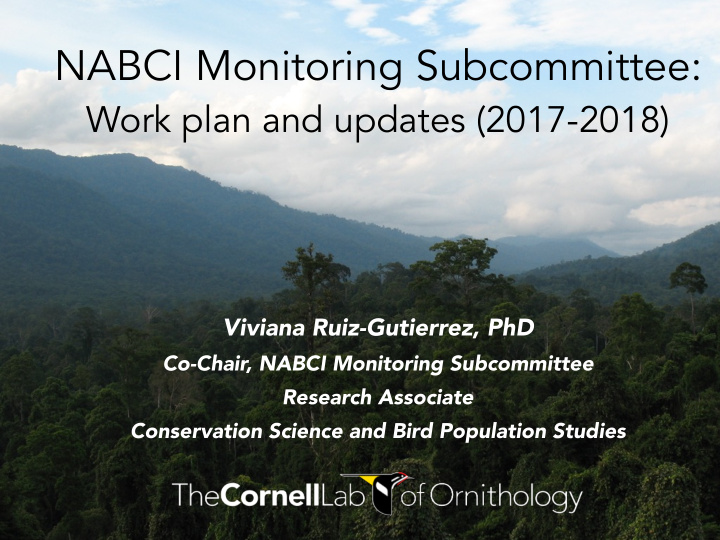



NABCI Monitoring Subcommittee: Work plan and updates (2017-2018) Viviana Ruiz-Gutierrez, PhD Co-Chair, NABCI Monitoring Subcommittee Research Associate Conservation Science and Bird Population Studies
Charge • To foster science on bird populations that can generate information relevant to conservation • To help different stakeholders make management decisions using the best available science
Updates 2017 • Searching for a Chair • Demographic document done! • Recommendations for NABCI community • Work Plan 2017-2018 • AOS Symposium and meeting
Recommendations 1. Adopt conceptual framework that guides integrated monitoring of North Americas’ resident and migratory birds into the future. 2. Acknowledge demographic monitoring as a means to better understand the timing, geography, and factors that limit bird populations . 3. Move toward a hemisphere-wide , integrated demographic monitoring network in which information is shared, resources magnified, and funding secured . 4. Review existing demographic monitoring programs and protocols, including MAPS and MoSI, to improve data quality and to adapt, improve and integrate efforts for better demographic monitoring of North America’s bird populations. 5. Coordinate and strengthen existing banding efforts to maximize information most relevant to demographic monitoring across the full annual cycle .
Recommendations 6. Foster improved data quality and analytical approaches to develop robust full annual cycle population models. 7. Expand demographic monitoring networks to increase geographic and temporal coverage, especially in Latin America and the Caribbean . Secure i nstitutional support and increased funding for integrated 8. demographic monitoring programs to ensure the long-term continuity of demographic information. Working within academic, government and NGO sectors, to ensure 9. monitoring efforts are linked to region- and country-specific conservation priorities and needs , in addition to broader full annual cycle monition and modeling objectives. 10. Integrate results from demographic monitoring into management and decision making to increase the probability that bird conservation actions can have actual positive population level impacts.
Work Plan 2017 Science and management 1. Linking science to management: • How to make the best use of available information and data? • Northeast Bird Monitoring Handbook as an example
Work Plan 2017 Citizen science and structured monitoring 1. Development and implementation of scalable, outcome-based bird monitoring programs • Private and Working Lands Subcommittee : Identify regional initiatives of NABCI partners to provide specific guidance on how to: • coordinate monitoring activities across individual projects to provide scalable inferences • harness the interest of researchers, agencies and the public
Work Plan 2017 Citizen science and structured monitoring 2. Structured Monitoring Programs in eBird • Best practices for bird monitoring in Latin America : In collaboration with Doug Robinson and AOS International Committee for count-based approaches, eventually for demographic monitoring 3. I mproved understanding of data storage and management • Description of current programs : Strengths and differences between the AKN and eBird
Work Plan 2017 Advances and best practices for data integration 1. Data sets that differ in spatial and temporal scales: • Integrate information from different count-based monitoring programs: Jointly analyze point-count data that differ in protocols, space and time (USFWS and BBS) 2. Demographic and count-based data: • Integrate information from point counts and banding programs: Development and applications of integrated population models (MAPS and BBS)
Work Plan 2017 Advances and best practices for data integration 3. Structured and non-structured information • Jointly analyze data from structured surveys with semi- structured citizen-science data (TCCB in California: state surveys + eBird)
Work Plan: updates AOS Symposia: Tools in Ornithology • Advances in estimating patterns of bird abundance and distributions at relevant spatial and temporal scales • Work that is supported by the Subcommittee 1. Cost-effective methods for collecting large volumes of high- quality, multi-scale information 2. Statistical methods that can integrate multiple sources of information across spatial and temporal scales
Work Plan: updates AOS Symposia: Tools in Ornithology • Advances in estimating patterns of bird abundance and distributions at relevant spatial and temporal scales • John Sauer (USGS), Jim Saracco (IBP) from NABCI Monitoring Subcommittee • US Fish and Wildlife Service, Cornell Lab of Ornithology, British Trust of Ornithology
Feedback and suggestions? • New Chair: Spring 2017? • Revised Workplan 2017-2018: March 2017 • Completed Demographic document: Summer 2017 • AOS Symposium: August 2017
Recommend
More recommend